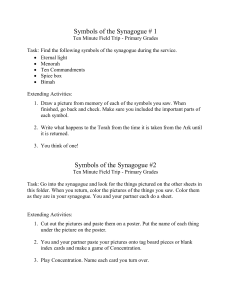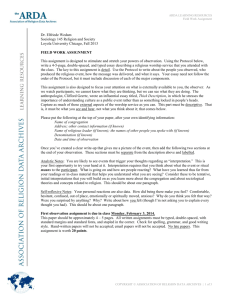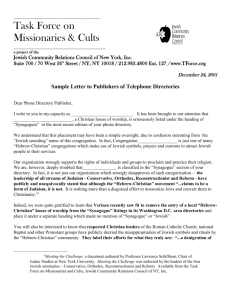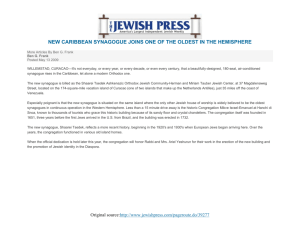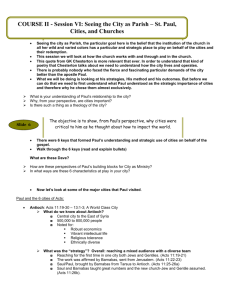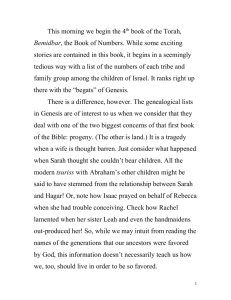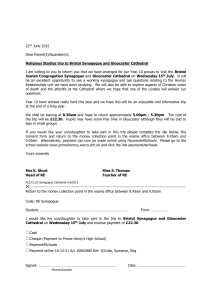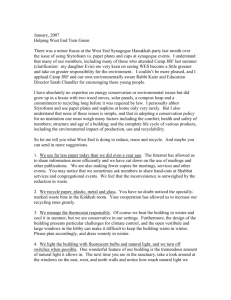The Great Synagogue, since 1878 a majestic feature of the
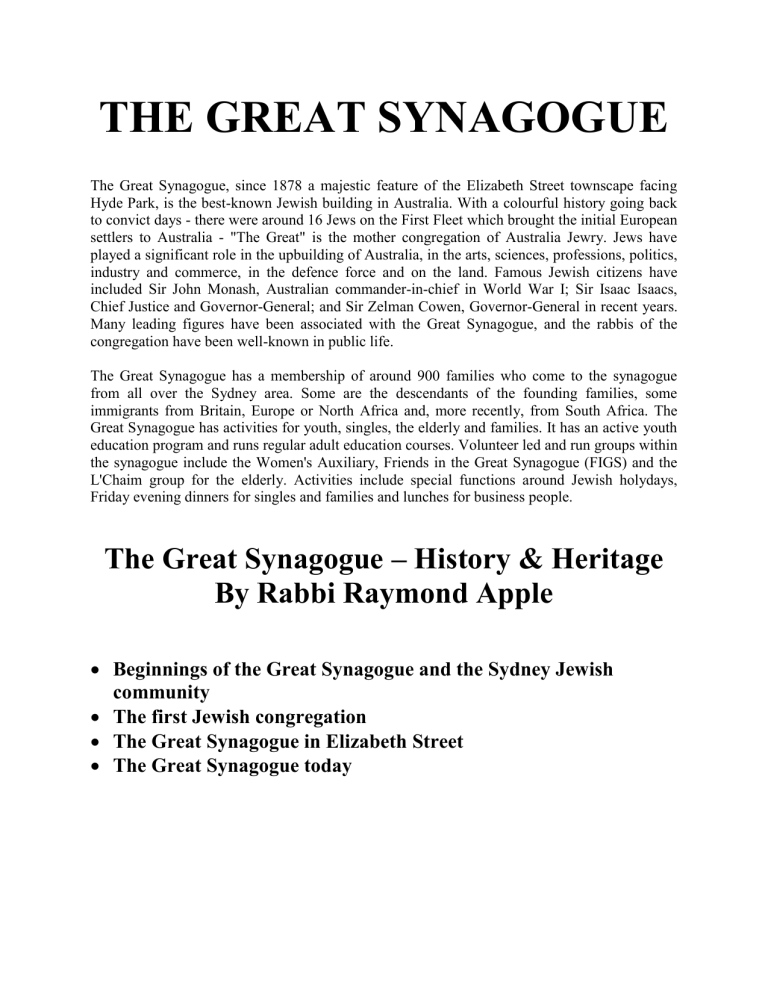
THE GREAT SYNAGOGUE
The Great Synagogue, since 1878 a majestic feature of the Elizabeth Street townscape facing
Hyde Park, is the best-known Jewish building in Australia. With a colourful history going back to convict days - there were around 16 Jews on the First Fleet which brought the initial European settlers to Australia - "The Great" is the mother congregation of Australia Jewry. Jews have played a significant role in the upbuilding of Australia, in the arts, sciences, professions, politics, industry and commerce, in the defence force and on the land. Famous Jewish citizens have included Sir John Monash, Australian commander-in-chief in World War I; Sir Isaac Isaacs,
Chief Justice and Governor-General; and Sir Zelman Cowen, Governor-General in recent years.
Many leading figures have been associated with the Great Synagogue, and the rabbis of the congregation have been well-known in public life.
The Great Synagogue has a membership of around 900 families who come to the synagogue from all over the Sydney area. Some are the descendants of the founding families, some immigrants from Britain, Europe or North Africa and, more recently, from South Africa. The
Great Synagogue has activities for youth, singles, the elderly and families. It has an active youth education program and runs regular adult education courses. Volunteer led and run groups within the synagogue include the Women's Auxiliary, Friends in the Great Synagogue (FIGS) and the
L'Chaim group for the elderly. Activities include special functions around Jewish holydays,
Friday evening dinners for singles and families and lunches for business people.
The Great Synagogue – History & Heritage
By Rabbi Raymond Apple
Beginnings of the Great Synagogue and the Sydney Jewish community
The first Jewish congregation
The Great Synagogue in Elizabeth Street
The Great Synagogue today
Beginnings of the Great Synagogue and the Sydney
Jewish community
The first petition to the governor Darling for a Jewish house of worship was refused. But by the late 1820s there were twenty-five free Jewish settlers, and they included influential people from distinguished families such as Joseph Barrow Montefiore: and it was felt the government would take more notice of them than of the emancipists. The formal establishment of the congregation came on 2 November, 1831 and the congregation formulated detailed rules of conduct. A committee member not attired in decent and respectable manner was to be fined a guinea for each such offence. No person could officiate at a service without permission from the president.
No conversation must take place during services; and "those Gentlemen being the junior branches of their families will take special care they behave themselves in a manner becoming a place of Divine Worship". The order of service and religious principles of the congregation were to be those laid down by the Chief Rabbi of London.
On 26 September 1832, a Sydney newspaper reported:
The Jews of the colony assembled at the Jews' Synagogue held over Mr Rowell's shop in George Street which is elegantly fitted out as such on Monday evening, being the last night of the year, according to the ancient chronology of the tribe of Judah, when prayers were said. On Tuesday morning and again in the evening, other meetings took place and worship was again performed.
… a wellarranged place of worship containing about one hundred seats, rented by the rate-payers, a reading desk, and pulpit for the officiating minister, and an Ark which contains the
Decalogue and a manuscript copy written on vellum of the
Books of Moses; also a ladies' gallery containing about thirty seats, fitted up with neat candelabras, etc.
The first minister was Rev Michael Rose, who arrived on 20 May, 1835. From 1832 to 1837 the congregation worshipped at George Street, but numbers had grown to over 300 adults and larger premises were leased at No 4 Bridge Street for 160 pounds a year.
The interior alterations had been made by Barnett Aaron Phillips, a stage carpenter who had worked at Drury Lane and built Australia's first stage scenery at Barnett Levey's Theatre Royal.
The handsome Ark from Bridge Street is probably the impressive small Ark which, recently restored, is on display outside the A.M. Rosenblum Jewish Museum. Dating from the 1830s, this
Ark would be one of the earliest pieces of ecclesiastical furniture in Australia.
The first Jewish congregation
The congregation soon decided that they needed a larger, specifically built synagogue in a central location. Governor Bourke had offered a grant of land but it was felt the location was
wrong. Governor Gipps granted a site in Kent Street North, but the preliminary excavations would have been beyond the resources of the congregation.
In the meantime, Bridge Street was vacated in 1840 and services were held in rooms over shops or dwellings owned by members of the congregation. Finally land was purchased in York Street, close to where the Sydney Town Hall stands today, and a synagogue was designed by James
Hume who had been associated with some of Sydney's finest buildings. The foundation stone was laid in 1842 and funds were donated liberally by both Jews and Christians.
Gentile interest in the project remained intense and the committee informed "all who may be desirous of visiting this place of worship that the attendance of members of all creeds is welcomed by the Jewish religionists". The building was consecrated on 2 April, 1844, with the music for the ceremony in the hands of Isaac Nathan, father of Australian music, who was also associated with the music at St Mary's Cathedral. For the occasion Nathan composed settings for
Baruch Habba ("Blessed be he that cometh") and Psalm 150.
York Street Synagogue was commodious (it had seating for 500) and elaborately furnished. Its
Ark, larger and even more impressive than that from Bridge Street, is also extant. It too has recently been restored, and it holds pride of place in our museum. The exterior of the synagogue was in the Egyptian style; similar buildings were erected by the congregations in Hobart (1845),
Launceston (1846) aand Adelaide (1850). The Hobart and Launceston Synagogues are still standing and in use.
Amongst the innovations of this period was the establishment of community registers of births, marriages and burials. These continue to this day, and the early tomes are cherished treasures of the Synagogue and are often consulted by historians and individuals interested in tracing their genealogy.
The late 1850s brought a controversy which split the congregation. The minister decided that a particular religious ritual was not permitted in the circumstances. In protest, some of the uppercrust establishment walked out and set up their own congregation in a former Baptist chapel in
Macquarie Street, almost adjacent to the present-day site of St Stephen's Church. However, York
Street continued to be well-attended whilst Macquarie Street struggled amidst internal disputes.
The minister at York Street from 1862 was the Rev Alexander Barnard Davis, formerly of
Kingston, Jamaica. In him the congregation found a man capable of fulfilling their need of "an
Englishman of Education and character, capable of delivering lectures or sermons in language, manner and tone, calculated to impress his hearers with devotion to their Creator and respect for the Minister". He is said to have had "a very beautiful voice, a very essential item in a Jewish
Minister, as he usually has to chant nearly the whole of the service and to give the keynote for the responses of the choir". Amongst the initiatives Davis took was the establishment of a permanent choir of six men and thirteen women with Mr Chislett as choirmaster.
Some decades late the preaching and cantorial roles of the ministers were separated and from
1909, when the Rev Marcus Einfeld took up office, there has been a professional cantor. The
mixed male-female choir continued until the end of 1974 when it was replaced with a choir of men and boys with the consequent need for re-organisation of much of the music.
The Great Synagogue in Elizabeth Street
Davis spearheaded moves for peace in the community, and as the 1870s developed, the amalgamation of the two Synagogues become possible. Macquarie Street was too small to house a united congregation; York Street could not be extended because the owner of the adjoining property would not sell, and finally a site in Elizabeth Street was purchased for 2000 pounds.
It was decided to build a Great Synagogue - great in relation to the two smaller places of worship that had preceded it, and because it reflected in its ritual and principles the historic Great
Synagogue in the City of London. An architectural competition for a design for the new
Synagogue was won by Thomas Rowe, one of Sydney's leading architects, who planned a building in what was described as Transitional French Gothic. For financial reasons his plans had to be modified, and ornate as some aspects of the present building are, Rowe had originally hoped for erect an even more elaborate building.
One of the most enterprising fund-raising ventures of the Synagogue building committee was a bazaar or fancy fair held over six days and nights in what is now Martin Place by the ladies of the congregation with much outside support including that of the Governor, Sir Hercules
Robinson. This raised 5000 pounds, nearly one fifth of the total cost of the building. The foundation stone was laid in 1875, and three years later, on 4 March, 1878, the Synagogue was consecrated in a ceremony enhanced by a choir and orchestra under Sydney Moss.
As the decades have passed the Synagogue has remained the Jewish cathedral of Sydney, though today the high-rise buildings on both sides tend to squash its exterior majesty. The growth of the
Jewish community and its suburban dispersal has brought the establishment of many other synagogues - a move which the elders of the Great at first tended to resist - but the Great has retained its stateliness and solemnity, and its busy programme of services and activities is supported by its large loyal congregation and provides a serene spiritual oasis in the midst of the bustling life of the city.
The building was described by the Illustrated Sydney News in 1878 as –
a place of worship which, for lavish adornment and superb finish, has no equal in the city of Sydney … It has a frontage of sixty-four feet and extends back one hundred and forty feet, embracing the whole of the intervening space between
Castlereagh and Elizabeth Streets. The style is composite - the
Byzantine prevailing, the Gothic being here and there introduced. The front of the edifice is built of freestone from the
Pyrmont quarries. Two square towers flank the central compartment, terminating in domes, and the entire façade is elaborately carved. The magnificent wheel window is a feature in
the front which strikes every eye. Passing through the principal entrance in Elizabeth Street, under a spacious porch supported by columns with richly carved caps, the visitor finds himself in the interior, which impresses him with a sense of ornate embellishment approaching the profuse … The seats face north and south, leaving a space in the centre unoccupied throughout.
At the western end of the nave, under a splendidly embellished arch, is the Ark, the floor being richly inlaid with Mosaic work - the steps ascending towards the Ark having massive ballustrading on each side. The columns in the nave supporting the clerestory are twenty-seven feet three inches high, and are surmounted by cusped arches with pointed labels, the spandrills of which are decorated with scroll foliage springing from the centre. The ceilings are semi-groined and panelled, with carved bosses at the intersections. The windows throughout are glazed with coloured glass in chaste designs in keeping with contour of the entire building.
A Christian minister from Melbourne reported after a visit in 1896:
The galleries are well filled, so is the amphitheatre like floor space. Facing the ark-alcove, but separated from it by a wide unoccupied space, is the Almemmar, or tribune, a highly ornamented wooden structure with seats for the Rabbis and presiding officials of the synagogue, and a spacious reading stand on which to repose the roll of the Torah, and up to which the successive readers of the lessons advance, supported on either hand by prominent members of the congregation … All the males in the body of synagogue wear the tallithim and have their hats on. As I took my seat the sweet musical voice of the second minister rose clear, plaintive, voicing the heart-cry of the children of the dispersion to their fathers' God to remember Zion and the set time to favour her. The musical Hebrew had a sobbing plaintiveness indescribably charming, ever and anon the congregation took up the responses. The venerable Chief Rabbi - the Reverend A.B. Davis - now takes his place at the reading stand; the sacred roll in unwound; the aged man, his natural force scarcely abated, in clear, ringing tones, a kind of semichant, recites the law of the Lord; the great congregation are on their feet. This is the psychological moment … Rabbi Davis, raising the sacred scroll high in air, descended from the tribune, and with slow and stately step, marched up the broad steps to the
Ark, in which he deposited the Law of the Lord … Then the Chief
Rabbi, taking his stand at the top of the flight of steps, in front of the Ark, preached his sermon; a wonderful effort for an aged man, delivered ore rotundo, with wonderful fire and passion …
As I passed into the life of the streets, and nineteenth century feeling again asserted its potency, I felt like one who had been in
Dreamland, and had heard things which it is not lawful for a man to speak to the fool multitude.
The Great Synagogue today
Since those days there have been a number of changes to the building. A.B. Davis had no pulpit as such; he preached or perhaps declaimed from the top of the steps leading to the Ark. There was no centre block of seats; towards the back of the empty centre space stood the reading platform from which the service was conducted. Towards the end of the 1890's a brass pulpit was erected on the steps leading to the Ark, and then, in 1906, the reading platform was moved forward, combined with the pulpit and placed in its present position on the Ark steps. This enabled extra seating to be installed in the centre of the building, but it was a move away from the traditional pattern whereby the service arises from the midst of the congregation.
At first there was a flat apse above the Ark, and the choir sang from one of the galleries at the opposite (Elizabeth Street) end of the building. When the present choir gallery was constructed, the opportunity was taken to build a ministers' robing room beneath it.
The lighting of the building was originally gas, and the old gas taps are still visible on the light fittings around the walls and the four upright seven-branched candelabra flanking the Ark steps and the choir gallery. An interesting original feature of the light fittings hanging in front of the ladies’ gallery is the six-pointed Star of David pattern that you see when looking up at them from beneath.
The gold-leaf stars on the ceiling were introduced about 75 years ago. Their purpose may have been to indicate that religion is a light and a lamp. Similar star-studded ceilings are especially common in some masonic buildings.
It is not known why there were never any windows along the side walls of the Synagogue. But there are twelve recessed arches on the ground floor and in their gallery, reminiscent of the twelve tribes of ancient Israel. The stained glass windows at the two ends of the buildings are chaste but nondescript; one window illustrating Jewish symbols was installed near the choir gallery, perhaps as the first of a series that was never completed. The wheel window remains an impressive sight, though concrete spokes were added in the 1940s to give it strength and support.
The internal columns used to be adorned with intricate floral motifs which were later painted over. They were rediscovered in 1981 when the education centre beside the Synagogue was in process of erection. Stencils based on these old motifs were then used to decorate the Synagogue itself and the various floors of the new centre, providing a link between generations a century apart.
At the Elizabeth Street end of the Synagogue, the only major change over the years has been the installation of the massive wrought-iron gates. Beneath the building, excavations in the 1950's made it possible to construct a war memorial centre, auditorium and library. Then in the 1980's
the education centre, erected between the Synagogue and Castlereagh Street and preserving the old Castlereagh Street façade, provided five floors for cultural, social and educational activity as well as modern offices, a Judaica shop, and a top-floor Succah or harvest tabernacle with a sliding roof.
The Great Synagogue has the atmosphere of a spacious cathedral-like edifice, especially on great occasions. Some find the building as too pompous and ornate. Members of the Great
Synagogue, however, like the relative formality and stateliness of their synagogue and its services, and enjoy the aesthetic dimension of its worship. But new ages bring new challenges, and congregational activities today deliberately endeavour to foster the feeling of fellowship and friendship that makes a congregation into a community.
* The author of this brief history has been senior rabbi of the congregation since December, 1972.
He also serves as senior rabbi to the Australian Defence Force, registrar of the Sydney Beth Din
(rabbinical court). He lectures in Judaic Studies at Sydney University and NSW Universities. He is active in interfaith and public affairs and is the leading spokesman for Judaism in Australia.
